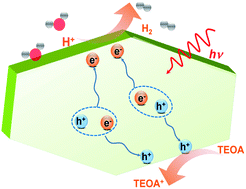Highly efficient photocatalytic hydrogen evolution based on conjugated molecular micro/nano-crystalline sheets†
Abstract
A novel conjugated organic molecule was constructed from an electron-donating unit (electron-donating benzo[1,2-b:5,4-b′]dithiophene) and electron-withdrawing groups (cyano and pyridine) and fabricated into sheet-shaped crystals. Intramolecular and intermolecular donor–acceptor interactions in crystals are beneficial to charge separation. A long-range ordered stacking mode through strong intermolecular interactions is conducive to electron migration (μe = 0.25 cm2 V−1 s−1) from the bulk to the surface of crystals and suppressing exciton recombination. The rugged surface and semitransparent feature of micro/nano-sheets improve the light capture and utilization efficiency of the photocatalyst. The high-crystallinity micro/nano-sheets exhibit a superior hydrogen evolution rate of 8143 μmol g−1 h−1, which is far beyond that of most reported organic conjugated molecular photocatalysts. Such an organic conjugated compound with a definite molecular structure offers a new prototype for further developing high-performance photocatalysts towards solar-to-chemical energy conversion.



 Please wait while we load your content...
Please wait while we load your content...